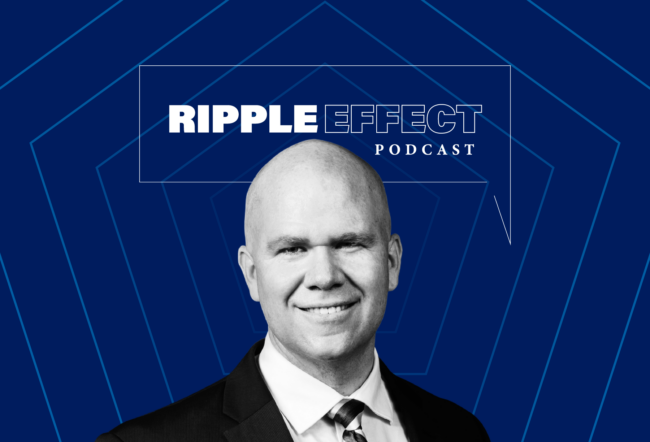Understanding human behavior is crucial for investors, according to Alliance Capital Management CEO Lewis A. Sanders, who talked about behavioral finance and its role in pricing anomalies and forecasting bias during a presentation last month at Wharton.
“Capital markets themselves are derivative of the biases and preferences people bring to decision-making,” Sanders told his audience, adding that insights into behavioral finance hold true across fixed-income, debt or equity markets and national boundaries. “People are people wherever you find them.”
Sanders, who spoke as part of part of Wharton’s Musser-Shoemaker Lecture series, has spent a career in investment research, starting as an analyst at Sanford C. Bernstein & Co., Inc. in 1968. He rose to become chairman of the firm, which merged in 2000 with Alliance, one of the world’s largest investment managers. In 2003, he was named chief executive of Alliance, which has $480 billion under management and 6.9 million mutual fund accounts.
At the moment, he said, markets are relatively calm and not generating big price anomalies. “The world is not in a very provocative state, but something will come along. Maybe it will be oil. Maybe it will be currency. Who knows, maybe it will be broadband. I can think of any number of developments.” He disputed conventional wisdom which says that superior information gives investors a leg up in making better decisions. “Everybody has the information. But are people reacting to it rationally?”
Asset prices are driven by three main human preferences, according to Sanders. The first is what he called “the overwhelming affection for things that are, or appear to be, certain.” For example, he said, most household wealth is in assets that have low, or no, volatility, at the expense of earning higher returns. Another trait that plays on markets is people’s tendency to ignore probability if a large payoff is at stake. “It’s going for the gold. Probability is essentially irrelevant,” said Sanders, who likens the behavior to lottery ticket sales that increase as the jackpot rises, even though the likelihood of winning diminishes. “In the capital markets this is a profound phenomenon because it fuels most bubbles.”
Another strong trait that plays out in markets is loss aversion. “In people’s minds, losses loom larger than gains,” said Sanders. “People just don’t like losing money. The only thing they dislike more are money managers who lose it for them.” In effect, Sanders argued, sellers fearful of losing money will wind up undercutting the price of their assets. “The sellers are paying the buyers to rid themselves of the stress of ownership that they can no longer endure.”
These traits are reflected in investing styles, according to Sanders. Value investors, he said, are willing to take on the stress, but in return they spend their lives “being depressed, afraid and subject to repeated threats to their self-esteem.” Growth investors seek a declining risk premium and are willing to pay more for perceived certainty. Finally, there are speculators, whom Sanders described as being often cloaked as growth investors, operating on “skewness” or extremes in price swings.
Human behavior also influences forecasting, Sanders told his audience. Much of the bias in market forecasts derives from “mental shortcuts. Typically, we’re overconfident.” Forecasters seek to find an anchor or reference point to build projections, but the anchor can be based in quicksand. Many forecasters focus too much on their own, recent experiences, Sanders noted, adding that corporate managers, too, seek anchors and will cling to business plans they have recently formulated even if the plan is not working. “All of this leads to inadequate judgments in the face of change.”
The “Inertia of Regret”
Investors create price anomalies when they are slow to change course due to what Sanders called the “inertia of regret. The regret associated with taking action is considerably greater than taking no action at all, which leads to inertia.”
Forecast biases are influenced by what Sanders identified as the availability heuristic – or judgments based on information that is easy-to-grasp and readily available in the decision-making environment. He pointed to the hype surrounding the stock market peaks during the Nifty Fifty craze in the early 1970s, the real estate bubble in the early 1990s and the spike in Internet stocks in 2000. “If you look at all the peaks, they are associated with very popular wide-spread ideas about what the future held. The winners and losers were divided along a simple boundary. In the Internet bubble it was the new economy versus the old economy. There was hopelessness around the old economy companies.
“Looking back [these bubbles] seem too obvious,” conceded Sanders, “but when you are in them, the ability to extrapolate what’s underway is very difficult.”
Sanders pointed to research indicating that consensus growth-rate forecasts for companies will remain on the same track, either fast or slow, as a cautionary sign. “People are very married to extrapolating recent success,” said Sanders, noting that in fact, very few companies remain on the same course and tend to revert to the mean. Moreover, forecasters often underestimate a poorly performing company’s ability to turn itself around. “An interesting bias is the inability to imagine that someone will conjure up a way out. You don’t see one and management hasn’t offered one. However, the probability is that with time and pressure they will, as all those mean reversions clearly imply.”
This so-called “failure of initiative” generates some of the best investment moves. He pointed to problems at Citigroup and IBM in the early 1990s that turned out to be opportunities. He also noted the forecasting danger of “misplaced concreteness.” What’s going on here “is the forecaster has proposed an elegant model with many variables and it fits so well you start to think you really have discovered something. People fall in love with these models.”
The problem, said Sanders, is that with more variables, data and complexity introduced to a model, the greater the chances it will implode. “The message in all of this is you have to understand that as forecasters you have limitations. Things are going to get blown around by the issues of the day. You have to wager with a certain sense of humility.”
Asked what psychological traits make good analysts, Sanders said drive would come first. Communication skills are also essential, not only the ability to write and articulate a position, but also to listen. “You’d be surprised how many research analysts don’t really listen. They develop a point of view and when they do an interview with someone who has knowledge, they don’t really pay attention. They’re more interested in supporting a preconceived view.”
Finally, Sanders said that while he looks for intelligence, brilliance can be a liability. “People who are brilliant spend their entire lives never being wrong. In a forecast setting they’re vulnerable. A little bit of insecurity is a good thing.”
Investment managers need to consider their fiduciary responsibility when building portfolios, Sanders concluded. He pointed out that it would have been responsible to acquire Citigroup in 1991 when the company appeared to be on the edge of failure. But a move like that is often difficult to justify to clients. The problem comes “when you can’t explain why you bought all this garbage … It’s difficult, without the depth of research to see through the anomalies, to explain why you will ultimately win and why you are not gambling with the client’s money.”
Maximum wealth “isn’t all there is to life,” Sanders added. “In the value world in particular, you make the most money by feeling the most insecure. Do you really want to do that with your life? Is it worth it?”



